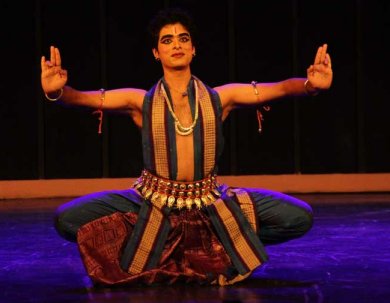
|   |

|   |
 e-mail: sunilkothari1933@gmail.com Young dancers put their best foot forward November 4, 2016 It was heartening to see the young generation of dancers putting their best foot forward in a three-day (Oct 18-20, 2016) dance and music festival organized by Raza Foundation. Uttaradhikar, conceived by Kathak dancer Prerana Shrimali, under the series of Guru Shishya Parampara, the disciples of senior dancers of Raza Foundation Awardees for dance and music were presented at Habitat Centre, Delhi. Also leading art historians and academic scholars were invited to give a brief history of tradition of Guru Shishya Parampara. I missed the proceedings of the first day, but caught up with the dance performances of the remaining two days - Bangalore based Jyotsna Jagannathan, disciple of A. Lakshman and Bragha Bessel and currently studying under Malavika Sarukkai, and Bhubaneswar based Soumya Bose, a disciple of Sujata Mohapatra. Both acquitted themselves well doing their gurus proud. Jyotsna has attractive stage presence and sound training in Bharatanatyam. Studying further under celebrated Bharatanatyam exponent Malavika Sarukkai, she has evidently polished her art, gaining insights into elements of space and time, the geometric lines enhancing the beauty of nritta and understanding nuances of abhinaya. Opening with Mallari choreographed by Malavika to music by Sitarama Sharma, Jyotsna created a favourable impression. It was further enhanced with Lalgudi Jayaraman's varnam set to Charukesi raga, in praise of Krishna. Alternating between pure and expressional dance, Jyotsna executed movements in flawlessly and registered bhavas in an engaging manner. Her beseeching of Krishna to accept her was moving, the sancharis, associate bhavas, poetic and emotive, comparing her desire to meet Krishna, like dry earth awaiting rain, was poignant. Varnam is a test for a dancer to display her command on technique and expressions. In a brief edition of the varnam, she succeeded in both aspects. Poochi Srinivas Iyengar's padam "Theruvil varano" narrating the procession of Lord Shiva and excitement of the nayika to have glimpses of Lord Shiva was replete with varying emotions, expectancy, excitement, impatience, disappointment at the delay and finally with joy, seeing the lord astride Nandi, his vehicle. Concluding with tillana in Sankarabharanam, Jyotsna impressed all present with her excellence, winning rounds of applause. The team of musicians gave her customary support, highlighting her dance.  Jyotsna Jagannathan
 Soumya Bose
Sujata Mohapatra's male disciple Soumya Bose presented choice Odissi numbers from his repertoire. Vishnu stuti followed by Trikhandi Bhumi Pranam showed his sound training under Sujata's supervision. Grammatically correct and with stamp of Guru Kelucharan Mohapatra's bani, his basic stance chowka and perfect resolutions of movements were noteworthy. It was a polished execution displaying beauty of pure dance. For a male dancer, Pallavi in Hamsadhwani was well choreographed eschewing the movements for feminine body, as there are less dance sculptures of male figures on walls of temples, from which Guru Kelucharan Mohapatra has drawn inspiration. Therefore, barring Darpani stance, nayika looking into mirror, other movements were appropriate. For a male dancer, the sculpturesque movements have to suit the temperament. The overall impression was aesthetic. It was in abhinaya number "Janano," poet Salbeg's composition "Ahe nila shaila" that Soumya succeeded in his ability to emote convincingly. Lord Vishnu rescuing Draupadi when Dushashana attempted to disrobe her in full view of the court was enacted dramatically, as was the episode of protecting Prahlada from Hiranyakashipu's wrath, when lord as Narasimha, half man and half lion form, vanquished him. Salbeg prays to Lord Jagannath that he is of lowly caste and a Muslim, but a devotee of his and begs him to give glimpse of his vision. It is a composition reverberating with contemporary issues advocating unity among communities, be one a dalit, a Muslim or a Hindu. All are equal and religion does not bar anyone from praying to god. The finale with Shankaracharya's 'Ardhanarishwara' Sanskrit composition offered scope to Soumya to alternate between graceful dance narrating beauty of Parvati and vigorous tandava nature of Lord Shiva and how both are found in one body, half female and half male. It is a gem of choreographic piece created by Kelubabu to the melodious music by Raghunath Panigrahi. He has interspersed pure dance in between the stanzas describing Parvati's adornments and Shiva's vigorous dancing ending in a pose of Shivalinga suggesting unity. Soumya did justice to the mood of the poem. Raza foundation and trustee Ashok Vajpayee along with Prerana Shrimali have rendered praiseworthy services to young dancers. The series will continue annually.  Dr. Sunil Kothari is a dance historian, scholar, author and critic. He is honored with Padma Shri, Sangeet Natak Akademi award and Senior Critic Award from Dance Critics Association, NYC. Post your comments Please provide your name and email id when you use the Anonymous profile in the blog to post a comment. All appropriate comments posted with name & email id in the blog will also be featured in the site. |